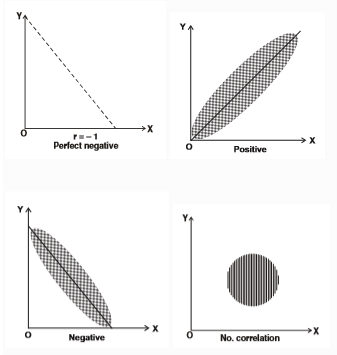Correlation Class 11 Economics
Introduction
- Correlation is a method used to find out how two things are related to each other.
- The correlation coefficient is a number that ranges from -1 to 1 and shows both the strength and direction of the relationship between the two things.
- If the correlation coefficient is close to zero, whether it is positive or negative, it means there is a weak or no relationship between the two variables.
- A correlation coefficient close to 1 indicates a positive relationship, which means that when one variable increases, the other variable also tends to increase.
- Conversely, a correlation coefficient close to -1 suggests a negative relationship, meaning that when one variable increases, the other variable tends to decrease.
- The correlation coefficient can be calculated for variables that are measured at the ordinal, interval, or ratio levels.
- However, it is not very meaningful for variables that are measured at the nominal level.

Type of Correlation
- Negative Correlation: Negative correlation occurs when two variables move in opposite directions, meaning that an increase in one variable is accompanied by a decrease in the other variable, and vice versa.
- Positive Correlation: Positive correlation is observed when two variables move in the same direction, meaning that an increase in one variable is accompanied by an increase in the other variable, and vice versa.
Examples of positive correlation are:
- Price and supply of a commodity.
- Increase in Height and Weight.
- Age of husband and age of wife.
- The family income and expenditure on luxury items.
Examples of negative correlation are:
- Sale of woollen garments and day temperature.
- Price and Demand of a commodity.
- Yield of crops and price.
Methods of estimating correlation:
- Scatter diagram
- Karl person’s coefficient of correlation.
- Spearman’s rank correlation.
A scatter plot provides a visual representation of the strength and direction of correlation between two variables. It involves plotting the x variable on the X-axis and the y variable on the Y-axis, resulting in a cluster of points called a scatter plot. The proximity and overall direction of the scatter points help us to analyze the relationship between the two variables.

Karl person’s coefficient of correlation is a quantitative method of calculating correlation. It gives a precise numerical value of the degree of linear relationship between two variables.
Karl person’s coefficient of correlation is also known as product-moment correlation.
Formula:
Here,
r = Coefficient of correlation
σx = Standard deviation of X-series.
σy = Standard deviation of Y-series.
N = Number of observations

- Karl Person’s coefficient of correlation is calculated by following methods:
Actual mean method:
Here,
r = Coeff. Of correlation
- Assumed Mean method:


Here,
dx = Deviations of x-series from assumed mean = (X – A)
dy = Deviation of Y-series from assumed mean = (Y – A)
∑dxdy = Sum of multiple of dx and dy.
∑dx2 = Sum of the square of dx.
∑dy2 = Sum of the square of dy
∑dx = Sum of the deviation of x-series
∑dy = Sum of the deviation of Y-series
N = Number of pairs of observations
When value of the variables are large, we use step deviation method to reduce the burden of calculation. - Step deviation method:

Here,
 dx = deviation of X-series from assumed mean = (X-A)
dx = deviation of X-series from assumed mean = (X-A)
dy = deviation of Y-series from assumed mean = (Y-A)
∑dxdy = Sum of multiple of dx and dy.
∑dx2 = Sum of the square of dx.
∑dy2 = Sum of the square of dy
∑dx = Sum of the deviation of x-series
∑dy = Sum of the deviation of Y-series
N = Number of pairs of observations
C1 is common factor for series -x
C2 is common factor for series -y
Spearman’s Rank Correlation
Spearman's rank correlation coefficient is a useful tool for determining the correlation between variables that may not have a clear or objective measurement. It is particularly helpful when analyzing the correlation of qualitative variables.
Here,
rs = coefficient of rank correlation
D = Rank differences
N = Number of rank
When ranks are repeated the formula is:
Where m1, m2, .............. are number of repetitions of ranks.
|
58 videos|215 docs|44 tests
|
FAQs on Correlation Class 11 Economics
| 1. What is Spearman's rank correlation? |  |
| 2. How is Spearman's rank correlation calculated? |  |
| 3. When should Spearman's rank correlation be used instead of Pearson's correlation? |  |
| 4. What is the interpretation of Spearman's rank correlation coefficient? |  |
| 5. Can Spearman's rank correlation coefficient be used for categorical variables? |  |

|
Explore Courses for Commerce exam
|

|






 dx = deviation of X-series from assumed mean = (X-A)
dx = deviation of X-series from assumed mean = (X-A)

















